
St. George icon, Zugdidi1849
Janashia Museum, Tbilisi
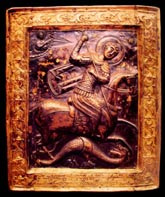
|
|
 |
 Although Saint George is the country's patron saint, the name Georgia derives from the Arabic and Persian words, Kurj or Gurj. Today it is called Sakartvelo in Georgian. 1991 brought the independence Georgia had longed for, breaking from the Russian empire, which it had been, a part since the beginning of the nineteenth century. Although Saint George is the country's patron saint, the name Georgia derives from the Arabic and Persian words, Kurj or Gurj. Today it is called Sakartvelo in Georgian. 1991 brought the independence Georgia had longed for, breaking from the Russian empire, which it had been, a part since the beginning of the nineteenth century.
|
|
Gudauri
photo: Woodcock 2002
 |
|
Georgia is situated at the crossroads of Europe and Asia, located in the region known, as the Caucasus or Caucasia, Georgia lies mostly in the Caucasus Mountains, and its northern boundary is partly defined by the greater Caucasus range. The lesser Caucasus range, which runs parallel to the south, creates natural barriers that are partly responsible for the cultural and linguistic differences in the region. The silk route passed through these mountains bringing the world to Georgia's doorstep.
 Georgian history is over 3000 years old and the ancient Georgian language is one of the oldest living languages in the world. The first findings of Georgian script date to the 6th century BC. Georgians do not use the Cyrillic alphabet: Georgian is an ancient and distinctive language, part of neither the Indo-European group nor the Turkic, and its written alphabet is one of only 14 in the world. Georgian history is over 3000 years old and the ancient Georgian language is one of the oldest living languages in the world. The first findings of Georgian script date to the 6th century BC. Georgians do not use the Cyrillic alphabet: Georgian is an ancient and distinctive language, part of neither the Indo-European group nor the Turkic, and its written alphabet is one of only 14 in the world.
Georgian text, David Gareja
photo: Woodcock 2002

|
|
 |
 One of the favorite stories the Georgians tell of themselves is how they came to call Georgia home. It seems that when God was passing out the earth to all humankind, the Georgians were busy with a feast - enjoying a hearty meal, drinking wine and toasting each other's health. When God found them after dividing up the earth, the Georgians insisted they were toasting God himself for such a bounty, and invited him to join the meal. God had such a good time he ended up giving these joyous people the land he had set aside for himself - paradise on earth. One of the favorite stories the Georgians tell of themselves is how they came to call Georgia home. It seems that when God was passing out the earth to all humankind, the Georgians were busy with a feast - enjoying a hearty meal, drinking wine and toasting each other's health. When God found them after dividing up the earth, the Georgians insisted they were toasting God himself for such a bounty, and invited him to join the meal. God had such a good time he ended up giving these joyous people the land he had set aside for himself - paradise on earth.
 Georgians have reason to believe they live in God's country. The mountains embrace fertile valleys, separate microclimates produce a wide variety of terrain to support everything from citrus to grain. Archaeologists have found evidence of viticulture almost 7,000 years and older, making it possible that the cultivation of the wine Georgians have reason to believe they live in God's country. The mountains embrace fertile valleys, separate microclimates produce a wide variety of terrain to support everything from citrus to grain. Archaeologists have found evidence of viticulture almost 7,000 years and older, making it possible that the cultivation of the wine
|
|
Supra
Nico Pirosmani
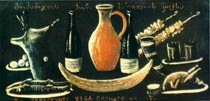 |
|
grape itself originated here in the Caucasus. A wide variety of Georgian reds, whites, and blush wines accompany every meal. While the wines of Western Europe are more well-known and internationally respected, at present Georgian wine is all but impossible to find outside of the country itself.
 As important as wine is, it is but an aspect of the grand ceremony of the shared meal. The "Supra", or Georgian table, is the ultimate act of hospitality, the evidence of the Georgian proverb that "an enemy may come as far as the door of your house, but once he enters he is a friend." A toastmaster or "tamada", is appointed to deliver toast after toast during the lengthy course of the abundant feast - to the guests, to the family, to kings and queens of Georgia's past, to God. With each toast another glass of wine is downed, and another glass poured. The sheer abundance of dishes prepared, served and devoured can be astounding, but it's all in the service of good will, and it's all delicious. As important as wine is, it is but an aspect of the grand ceremony of the shared meal. The "Supra", or Georgian table, is the ultimate act of hospitality, the evidence of the Georgian proverb that "an enemy may come as far as the door of your house, but once he enters he is a friend." A toastmaster or "tamada", is appointed to deliver toast after toast during the lengthy course of the abundant feast - to the guests, to the family, to kings and queens of Georgia's past, to God. With each toast another glass of wine is downed, and another glass poured. The sheer abundance of dishes prepared, served and devoured can be astounding, but it's all in the service of good will, and it's all delicious.
Bolnisi Sioni temple
478-493 A.D.
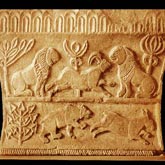
|
|
 |
 The churches and public buildings of Georgia evoke a monumental sense of importance coupled with natural gracefulness, as if the architects and masons have learned to dance with stone. The tradition of creativity continues with painters and sculptors of today. The churches and public buildings of Georgia evoke a monumental sense of importance coupled with natural gracefulness, as if the architects and masons have learned to dance with stone. The tradition of creativity continues with painters and sculptors of today.
|
|
Shuamta, Kakhetia
photo: Woodcock 2002
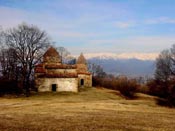 |
|
 As one of the oldest cultures in the world, Georgia has more than its share of monuments to an illustrious past. Most notable are the early Christian churches, dating from the 4th century onward, powerful structures of stone that have their roots not only in the public architecture of Rome and Byzantium but the traditional homes of Iberia, or eastern Georgia. The circular floor plan surmounted by a dome structure, which originally was vented to allow wood smoke to escape, lent itself symbolically to the vaulted dome of heaven in religious structures. Persian occupation added a new element, and in the nineteenth century Russian domination created a hybrid architectural style visible in many buildings in the capital, Tbilisi. The so-called Stalinist architecture of As one of the oldest cultures in the world, Georgia has more than its share of monuments to an illustrious past. Most notable are the early Christian churches, dating from the 4th century onward, powerful structures of stone that have their roots not only in the public architecture of Rome and Byzantium but the traditional homes of Iberia, or eastern Georgia. The circular floor plan surmounted by a dome structure, which originally was vented to allow wood smoke to escape, lent itself symbolically to the vaulted dome of heaven in religious structures. Persian occupation added a new element, and in the nineteenth century Russian domination created a hybrid architectural style visible in many buildings in the capital, Tbilisi. The so-called Stalinist architecture of
Mtskheta, Jvari Church
David Tskhadadze 2000
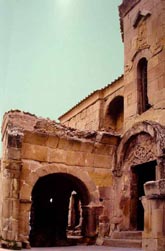
|
|
 |
the mid-twentieth century also left its mark on the capital.
 The Arab invasion in the seventh century interrupted this early creativity, but brought new artistic influences into the mix. The architecture of Georgia has often been called Byzantine, but its influences are more wide-ranging due to its location at the crossroads of so many cultural influences. By the 11th and 12th centuries Georgia's renaissance was well underway, and again the churches were dramatic expressions of skill and aesthetics. The Arab invasion in the seventh century interrupted this early creativity, but brought new artistic influences into the mix. The architecture of Georgia has often been called Byzantine, but its influences are more wide-ranging due to its location at the crossroads of so many cultural influences. By the 11th and 12th centuries Georgia's renaissance was well underway, and again the churches were dramatic expressions of skill and aesthetics.
|
|
Ateni fresco
VII Century
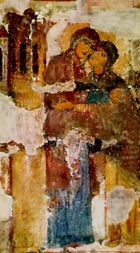 |
|
The structures at Mtskheta, the old capital just outside of Tbilisi, are good examples.
 Paintings, sculpture and representational art were not permitted in early church structures, due to religious reasons, but after the 11th century a more humanistic tradition appeared. Fresco art such as found at David-Gareja and Vardzia are like windows into the past with their portraits of royalty and religious themes. Mural art blossomed too, and over the next centuries Byzantine and Persian influences penetrated the Caucasus. Sadly, the Russians destroyed many monuments of this and the later periods in the nineteenth century. Paintings, sculpture and representational art were not permitted in early church structures, due to religious reasons, but after the 11th century a more humanistic tradition appeared. Fresco art such as found at David-Gareja and Vardzia are like windows into the past with their portraits of royalty and religious themes. Mural art blossomed too, and over the next centuries Byzantine and Persian influences penetrated the Caucasus. Sadly, the Russians destroyed many monuments of this and the later periods in the nineteenth century.
 In the 19th century, painting became a more important In the 19th century, painting became a more important
The Feast – Nico Pirosmani
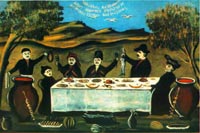
|
|
 |
aesthetic outlet for Georgians living under the rule of the Russian czars. Then as the 20th century dawned what became Georgia's most celebrated painter was discovered living the life of a beggar in the streets of Tbilisi. Niko Pirosmani, a self-taught sign painter, produced perhaps 2,000 paintings primarily as trade for drinks, even after his discovery by three Russian artists in 1912. He died a pauper in 1918, and while most of his work has been lost, his colorful naïve, primitive style is thought typical of Georgian folk art.
|



